
Do you serve your best food on ugly plates? Are you still using the saucers from your mom's back closet from when you moved away from home? Or do you instead spend all your birthday money on new additions to your Floral Heaven dinnerware set, dreaming of one day completing the whole thing to impress your grandma?
I guess most of the readers here care more about what goes on the plate than what goes on underneath the food.
Which is fair enough as this
is a
food blog. But to a lot of people, that's just not good enough. When enjoying the meal, everything has to go hand in hand with the taste, the elegance; it is the complete and dignified experience.
At least that's what our high society grandfathers believed. The Japanese went all out with the
wabi sabi style, perfecting every detail of the dining experience, even among humble villagers. And in the Western world, nothing could beat a fancy meal served on good china. That is, after 1711 when Europe for the first time finally were able to put porcelain into production and after decades of trying to reproduce the fine products from the distant lands of China.
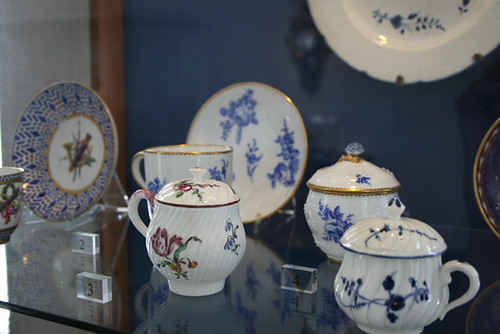
Before we had porcelain to serve our fatty pork and stale bread on, the Western world used plates of tin, copper, wood and low-fired clayware which were all heavy and clumsy--quite the opposite of the Asian elegance and refinement.
To celebrate the 300-year anniversary of creating good china in Europe, the Copenhagen based
Design Museum has arranged a small show and opened up their abundant collection of decadent porcelain affairs to the public. I dropped by this Sunday to find inspiration for my own dinner parties.
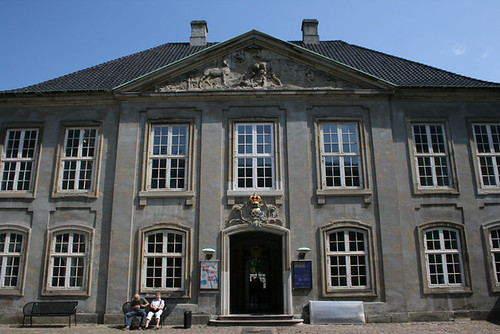
The Designmuseum Danmark is situated in the most fancy part of Copenhagen, right next to Amalienborg, residence of Her Majesty Queen Margrethe II and the rest of the royal family.
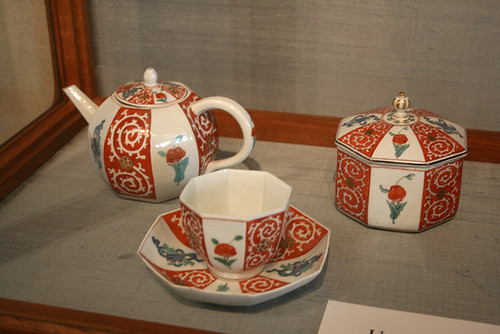 European porcelan from the 17th century inspired by the decorative Chinese style.
European porcelan from the 17th century inspired by the decorative Chinese style.
Fancy porcelain was invented in China for almost 2,500 years ago. The first pieces of Chinese porcelain came to Europe in the 13th century via the Silk Road (think heavy stuff on horsebacks).
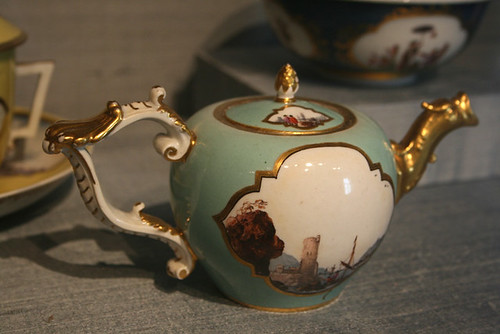 A Europe-produced teapot in an oriental style with a scenic motif and gold details.
A Europe-produced teapot in an oriental style with a scenic motif and gold details.
From the 14th century and onwards the import grew steadily--the fascination of the thin, white material was instantly there, but the manufacturing process was not easy and the Chinese kept their secrets to themselves (ha, surprise!).
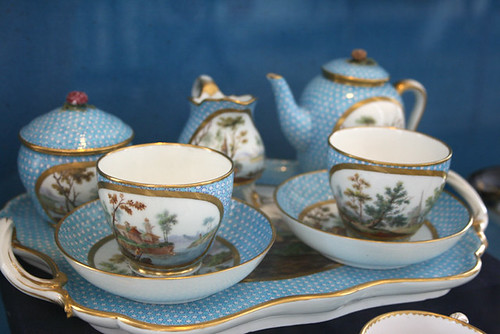 Early European china, looking like a doll's tea set.
Early European china, looking like a doll's tea set.
Not before 1710 a factory in the German city Meissen succeeded in creating porcelain of the same quality as the Chinese. Soon porcelain, called "the white gold", became a sought-after luxury and a much-appreciated collector's item at the European royal courts who enjoyed sipping their tea from beautiful delicate cups and gossiping over biscuits served on white sparkly plates. I bet the gays were up in the air too posing with their pointed little fingers on the fancy cups in their well-powdered wigs.
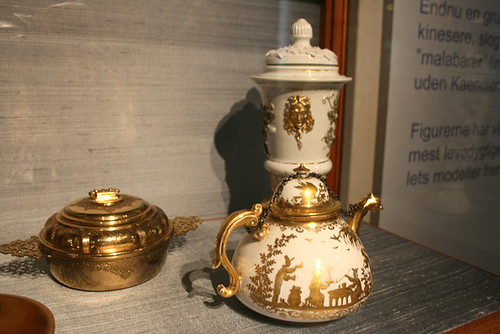
From Meissen the technique spread quickly and during the 17th century porcelain factories popped up all around Europe. In 1775 we even had our own factory here in Denmark--known today as Royal Copenhagen, yay! Today mostly rich gay people, bewildered tourists and grandmothers appreciate traditional porcelain dinnerware. But for other uses porcelain is most popular among the young arts and crafts generation.
View of the marvelous room containing the "
Study Collection of European Faience and Porcelain 1700-1880":
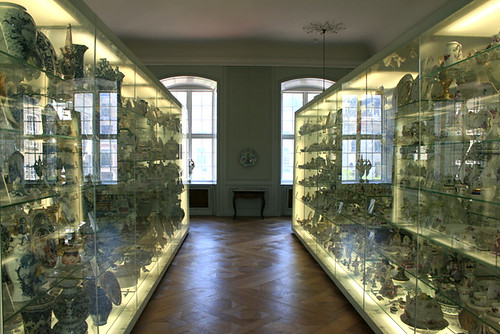
The study room contains thousands of pieces of china.
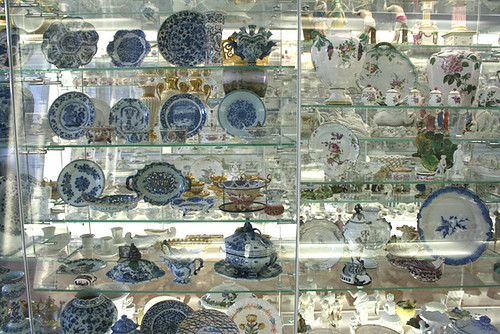
It feels like stepping into a flowing universe of so many dinner parties through the 1770s, afternoon tea settings in a forest on May 12, 1835, beach venture on a sunny afternoon on a hot July day in 1801. All these objects and all these lives they have followed, and survived. All the people have gone, all the parties and meals are long forgotten. But the food vessels are still here.
Will your hot cup of coffee next to your computer be put on display in a glassbox in 2127 when your life is long gone? Perhaps your grand children will visit the museum and spare a second of their busy hi-tech life, looking at their grandfather's worn out
Umamimart mug?

I took a walk around the glass montres amazed. But I think we have seen enough tea cups already so I tried to spot some of the porcelain dinner/teaware elements that stood out.
These cork wine bottle plugs look almost exactly like the ones you find in stores in 2011:
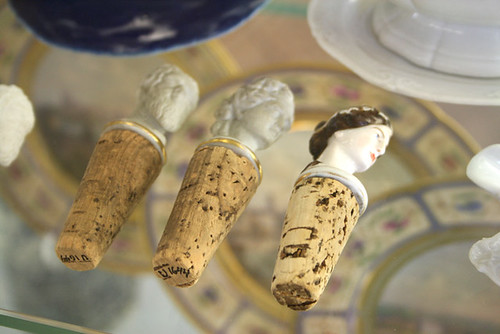 Perhaps these portraits were famous composers of the time, or maybe the head of the family, a caring mother, a secret mistress...
Perhaps these portraits were famous composers of the time, or maybe the head of the family, a caring mother, a secret mistress...
These stands are fun! Psychedelic tree trunks holding up a porcelain flower for bread, biscuits or lush cake.
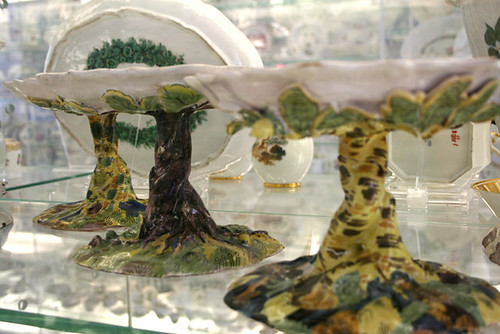
And I love this little fella working fulltime as a sauce can handle. Such exquisite detailing:

Alert doves on their nests--perhaps a bowl for eggs, sugar or cookies?
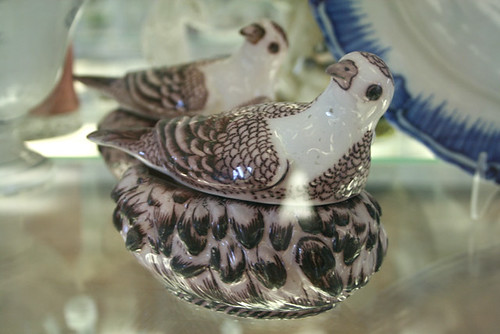
A diabolical beast crowning an oriental-style bowl lid.
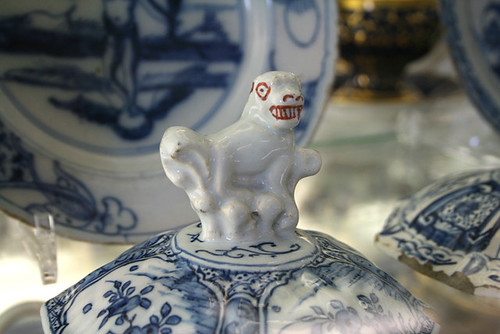
Porcelain plate with no room for food. Porcelain can be both cast and hand modelled like traditional clay:

Figurine man stealing eggs from a nest for his fab gay Sunday brunch.
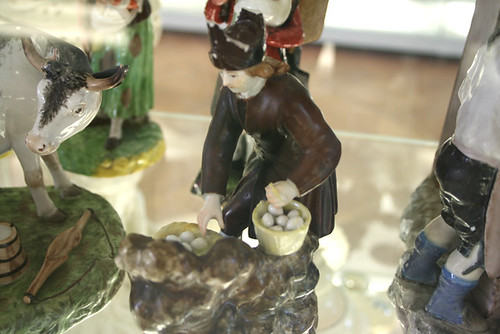
Farmer lesbian killing some ducks...
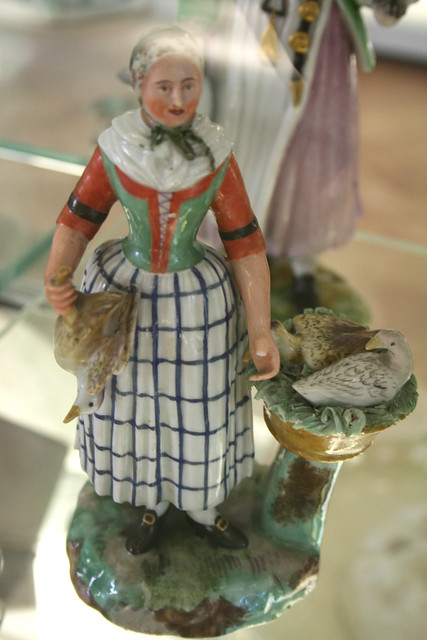 ...because lesbian women are violent and only like cats and other woman.
...because lesbian women are violent and only like cats and other woman.
The village beauty who is also a lesbian:
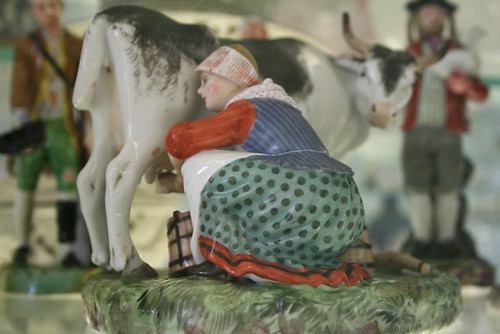 Back the day, lesbians were burned at the stake for their witchery, so the only way they could get their hands on some titties was by milking the cow.
Back the day, lesbians were burned at the stake for their witchery, so the only way they could get their hands on some titties was by milking the cow.
A gigantic cupcake holder for 17th century outdoor garden parties:
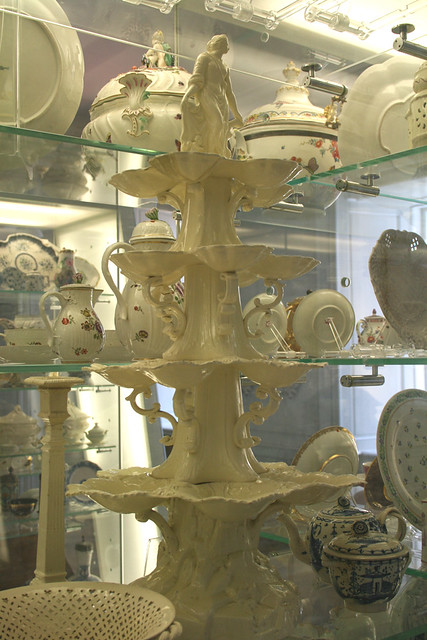
This object would work fantastic as a macaron holder at your incredible gay Hampton summer wedding in 2012, Yamahomo!
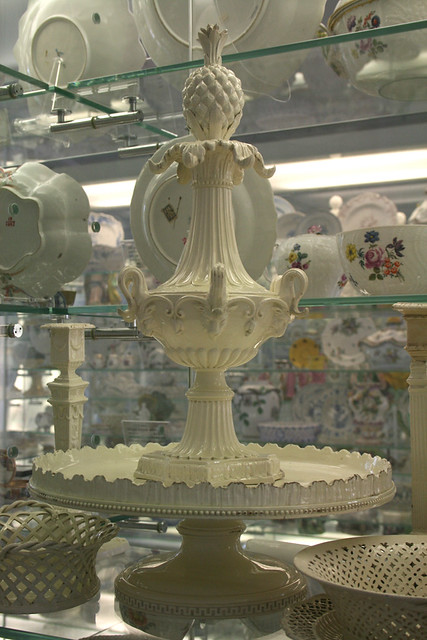
This piece is so weird and mysterious too. A hand-thrown faience (white pottery clay with tin slip glaze) bowl with attached sea corals on the bottom:
 Must have been quite the centre of attention when used to serve pudding at a royal court ballroom party.
Must have been quite the centre of attention when used to serve pudding at a royal court ballroom party.
Nice vase (for a secret stash of mint drops?) in the window...
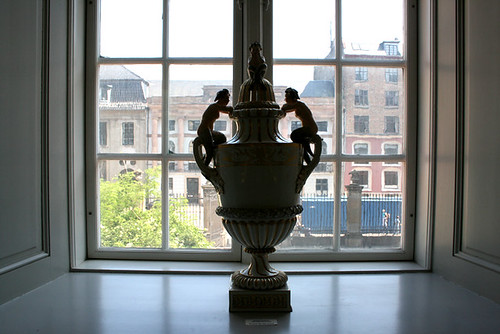
... and its mermaids are parading their bums:
 Yamahomo and friends, keep your dirty paws off this one!
Yamahomo and friends, keep your dirty paws off this one!
After all this porcelain I almost overdosed and had to sneak down to the Japanese historical crafts department to surround myself with what I personally prefer on my own dinner table:
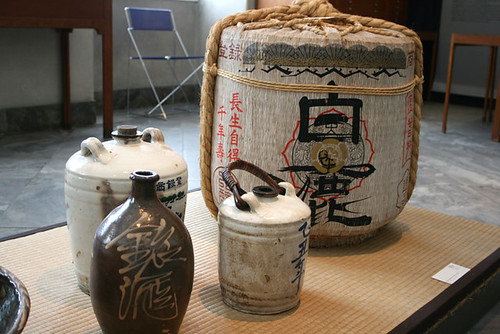 To me, this is true pottery--a reflection of the natural elements of fire, wood, earth, wind.
To me, this is true pottery--a reflection of the natural elements of fire, wood, earth, wind.
Ancient bowls used for traditional tea ceremonies, perhaps by a samurai and his fellow warriors:
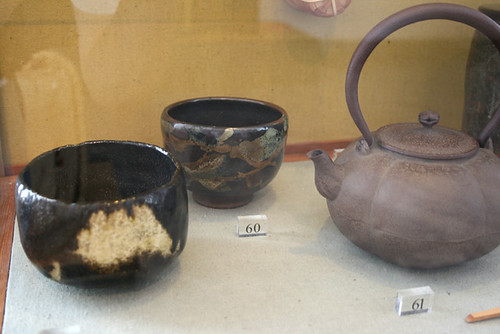 It's beautiful, natural, masculine and humble.
It's beautiful, natural, masculine and humble.
Dying for cold liquid (it's 28˚C in Copenhagen this week--two months early for those kind of high temperatures) so I walk to the cafe.
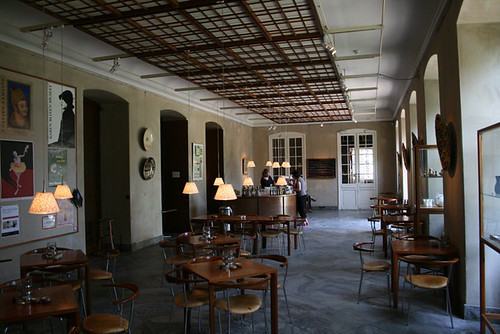
A selection of different Danish beer, sodas and organic locally grown lemonades with elderberry, blueberry, etc.:
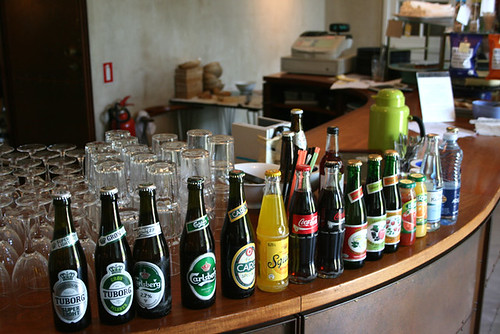
I sit out in the garden next to the museum walls surrounding the whole court yard:
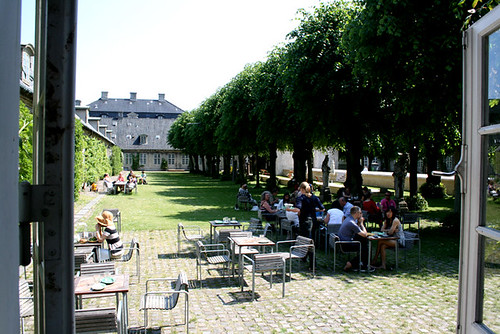
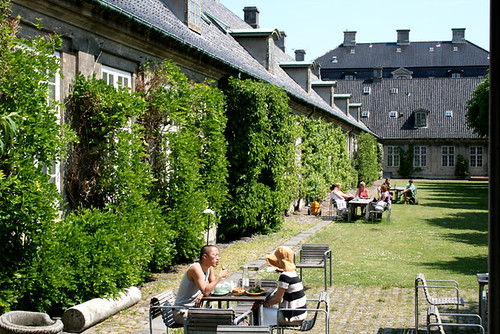
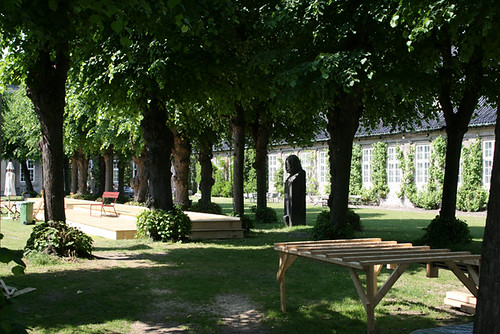
Summer is here--let's enjoy our food and drinks whatever way and wherever we choose to serve it. And try to enjoy the moment, because the fact is, our plate is going to be here longer than we are.
 Do you serve your best food on ugly plates? Are you still using the saucers from your mom's back closet from when you moved away from home? Or do you instead spend all your birthday money on new additions to your Floral Heaven dinnerware set, dreaming of one day completing the whole thing to impress your grandma?
I guess most of the readers here care more about what goes on the plate than what goes on underneath the food.
Which is fair enough as this is a food blog. But to a lot of people, that's just not good enough. When enjoying the meal, everything has to go hand in hand with the taste, the elegance; it is the complete and dignified experience.
At least that's what our high society grandfathers believed. The Japanese went all out with the wabi sabi style, perfecting every detail of the dining experience, even among humble villagers. And in the Western world, nothing could beat a fancy meal served on good china. That is, after 1711 when Europe for the first time finally were able to put porcelain into production and after decades of trying to reproduce the fine products from the distant lands of China.
Do you serve your best food on ugly plates? Are you still using the saucers from your mom's back closet from when you moved away from home? Or do you instead spend all your birthday money on new additions to your Floral Heaven dinnerware set, dreaming of one day completing the whole thing to impress your grandma?
I guess most of the readers here care more about what goes on the plate than what goes on underneath the food.
Which is fair enough as this is a food blog. But to a lot of people, that's just not good enough. When enjoying the meal, everything has to go hand in hand with the taste, the elegance; it is the complete and dignified experience.
At least that's what our high society grandfathers believed. The Japanese went all out with the wabi sabi style, perfecting every detail of the dining experience, even among humble villagers. And in the Western world, nothing could beat a fancy meal served on good china. That is, after 1711 when Europe for the first time finally were able to put porcelain into production and after decades of trying to reproduce the fine products from the distant lands of China.
 Before we had porcelain to serve our fatty pork and stale bread on, the Western world used plates of tin, copper, wood and low-fired clayware which were all heavy and clumsy--quite the opposite of the Asian elegance and refinement.
To celebrate the 300-year anniversary of creating good china in Europe, the Copenhagen based Design Museum has arranged a small show and opened up their abundant collection of decadent porcelain affairs to the public. I dropped by this Sunday to find inspiration for my own dinner parties.
Before we had porcelain to serve our fatty pork and stale bread on, the Western world used plates of tin, copper, wood and low-fired clayware which were all heavy and clumsy--quite the opposite of the Asian elegance and refinement.
To celebrate the 300-year anniversary of creating good china in Europe, the Copenhagen based Design Museum has arranged a small show and opened up their abundant collection of decadent porcelain affairs to the public. I dropped by this Sunday to find inspiration for my own dinner parties.
 The Designmuseum Danmark is situated in the most fancy part of Copenhagen, right next to Amalienborg, residence of Her Majesty Queen Margrethe II and the rest of the royal family.
The Designmuseum Danmark is situated in the most fancy part of Copenhagen, right next to Amalienborg, residence of Her Majesty Queen Margrethe II and the rest of the royal family.
 European porcelan from the 17th century inspired by the decorative Chinese style.
Fancy porcelain was invented in China for almost 2,500 years ago. The first pieces of Chinese porcelain came to Europe in the 13th century via the Silk Road (think heavy stuff on horsebacks).
European porcelan from the 17th century inspired by the decorative Chinese style.
Fancy porcelain was invented in China for almost 2,500 years ago. The first pieces of Chinese porcelain came to Europe in the 13th century via the Silk Road (think heavy stuff on horsebacks).
 A Europe-produced teapot in an oriental style with a scenic motif and gold details.
From the 14th century and onwards the import grew steadily--the fascination of the thin, white material was instantly there, but the manufacturing process was not easy and the Chinese kept their secrets to themselves (ha, surprise!).
A Europe-produced teapot in an oriental style with a scenic motif and gold details.
From the 14th century and onwards the import grew steadily--the fascination of the thin, white material was instantly there, but the manufacturing process was not easy and the Chinese kept their secrets to themselves (ha, surprise!).
 Early European china, looking like a doll's tea set.
Not before 1710 a factory in the German city Meissen succeeded in creating porcelain of the same quality as the Chinese. Soon porcelain, called "the white gold", became a sought-after luxury and a much-appreciated collector's item at the European royal courts who enjoyed sipping their tea from beautiful delicate cups and gossiping over biscuits served on white sparkly plates. I bet the gays were up in the air too posing with their pointed little fingers on the fancy cups in their well-powdered wigs.
Early European china, looking like a doll's tea set.
Not before 1710 a factory in the German city Meissen succeeded in creating porcelain of the same quality as the Chinese. Soon porcelain, called "the white gold", became a sought-after luxury and a much-appreciated collector's item at the European royal courts who enjoyed sipping their tea from beautiful delicate cups and gossiping over biscuits served on white sparkly plates. I bet the gays were up in the air too posing with their pointed little fingers on the fancy cups in their well-powdered wigs.
 From Meissen the technique spread quickly and during the 17th century porcelain factories popped up all around Europe. In 1775 we even had our own factory here in Denmark--known today as Royal Copenhagen, yay! Today mostly rich gay people, bewildered tourists and grandmothers appreciate traditional porcelain dinnerware. But for other uses porcelain is most popular among the young arts and crafts generation.
View of the marvelous room containing the "Study Collection of European Faience and Porcelain 1700-1880":
From Meissen the technique spread quickly and during the 17th century porcelain factories popped up all around Europe. In 1775 we even had our own factory here in Denmark--known today as Royal Copenhagen, yay! Today mostly rich gay people, bewildered tourists and grandmothers appreciate traditional porcelain dinnerware. But for other uses porcelain is most popular among the young arts and crafts generation.
View of the marvelous room containing the "Study Collection of European Faience and Porcelain 1700-1880":
 The study room contains thousands of pieces of china.
The study room contains thousands of pieces of china.
 It feels like stepping into a flowing universe of so many dinner parties through the 1770s, afternoon tea settings in a forest on May 12, 1835, beach venture on a sunny afternoon on a hot July day in 1801. All these objects and all these lives they have followed, and survived. All the people have gone, all the parties and meals are long forgotten. But the food vessels are still here.
Will your hot cup of coffee next to your computer be put on display in a glassbox in 2127 when your life is long gone? Perhaps your grand children will visit the museum and spare a second of their busy hi-tech life, looking at their grandfather's worn out Umamimart mug?
It feels like stepping into a flowing universe of so many dinner parties through the 1770s, afternoon tea settings in a forest on May 12, 1835, beach venture on a sunny afternoon on a hot July day in 1801. All these objects and all these lives they have followed, and survived. All the people have gone, all the parties and meals are long forgotten. But the food vessels are still here.
Will your hot cup of coffee next to your computer be put on display in a glassbox in 2127 when your life is long gone? Perhaps your grand children will visit the museum and spare a second of their busy hi-tech life, looking at their grandfather's worn out Umamimart mug?
 I took a walk around the glass montres amazed. But I think we have seen enough tea cups already so I tried to spot some of the porcelain dinner/teaware elements that stood out.
These cork wine bottle plugs look almost exactly like the ones you find in stores in 2011:
I took a walk around the glass montres amazed. But I think we have seen enough tea cups already so I tried to spot some of the porcelain dinner/teaware elements that stood out.
These cork wine bottle plugs look almost exactly like the ones you find in stores in 2011:
 Perhaps these portraits were famous composers of the time, or maybe the head of the family, a caring mother, a secret mistress...
These stands are fun! Psychedelic tree trunks holding up a porcelain flower for bread, biscuits or lush cake.
Perhaps these portraits were famous composers of the time, or maybe the head of the family, a caring mother, a secret mistress...
These stands are fun! Psychedelic tree trunks holding up a porcelain flower for bread, biscuits or lush cake.
 And I love this little fella working fulltime as a sauce can handle. Such exquisite detailing:
And I love this little fella working fulltime as a sauce can handle. Such exquisite detailing:
 Alert doves on their nests--perhaps a bowl for eggs, sugar or cookies?
Alert doves on their nests--perhaps a bowl for eggs, sugar or cookies?
 A diabolical beast crowning an oriental-style bowl lid.
A diabolical beast crowning an oriental-style bowl lid.
 Porcelain plate with no room for food. Porcelain can be both cast and hand modelled like traditional clay:
Porcelain plate with no room for food. Porcelain can be both cast and hand modelled like traditional clay:
 Figurine man stealing eggs from a nest for his fab gay Sunday brunch.
Figurine man stealing eggs from a nest for his fab gay Sunday brunch.
 Farmer lesbian killing some ducks...
Farmer lesbian killing some ducks...
 ...because lesbian women are violent and only like cats and other woman.
The village beauty who is also a lesbian:
...because lesbian women are violent and only like cats and other woman.
The village beauty who is also a lesbian:
 Back the day, lesbians were burned at the stake for their witchery, so the only way they could get their hands on some titties was by milking the cow.
A gigantic cupcake holder for 17th century outdoor garden parties:
Back the day, lesbians were burned at the stake for their witchery, so the only way they could get their hands on some titties was by milking the cow.
A gigantic cupcake holder for 17th century outdoor garden parties:
 This object would work fantastic as a macaron holder at your incredible gay Hampton summer wedding in 2012, Yamahomo!
This object would work fantastic as a macaron holder at your incredible gay Hampton summer wedding in 2012, Yamahomo!
 This piece is so weird and mysterious too. A hand-thrown faience (white pottery clay with tin slip glaze) bowl with attached sea corals on the bottom:
This piece is so weird and mysterious too. A hand-thrown faience (white pottery clay with tin slip glaze) bowl with attached sea corals on the bottom:
 Must have been quite the centre of attention when used to serve pudding at a royal court ballroom party.
Nice vase (for a secret stash of mint drops?) in the window...
Must have been quite the centre of attention when used to serve pudding at a royal court ballroom party.
Nice vase (for a secret stash of mint drops?) in the window...
 ... and its mermaids are parading their bums:
... and its mermaids are parading their bums:
 Yamahomo and friends, keep your dirty paws off this one!
After all this porcelain I almost overdosed and had to sneak down to the Japanese historical crafts department to surround myself with what I personally prefer on my own dinner table:
Yamahomo and friends, keep your dirty paws off this one!
After all this porcelain I almost overdosed and had to sneak down to the Japanese historical crafts department to surround myself with what I personally prefer on my own dinner table:
 To me, this is true pottery--a reflection of the natural elements of fire, wood, earth, wind.
Ancient bowls used for traditional tea ceremonies, perhaps by a samurai and his fellow warriors:
To me, this is true pottery--a reflection of the natural elements of fire, wood, earth, wind.
Ancient bowls used for traditional tea ceremonies, perhaps by a samurai and his fellow warriors:
 It's beautiful, natural, masculine and humble.
Dying for cold liquid (it's 28˚C in Copenhagen this week--two months early for those kind of high temperatures) so I walk to the cafe.
It's beautiful, natural, masculine and humble.
Dying for cold liquid (it's 28˚C in Copenhagen this week--two months early for those kind of high temperatures) so I walk to the cafe.
 A selection of different Danish beer, sodas and organic locally grown lemonades with elderberry, blueberry, etc.:
A selection of different Danish beer, sodas and organic locally grown lemonades with elderberry, blueberry, etc.:
 I sit out in the garden next to the museum walls surrounding the whole court yard:
I sit out in the garden next to the museum walls surrounding the whole court yard:


 Summer is here--let's enjoy our food and drinks whatever way and wherever we choose to serve it. And try to enjoy the moment, because the fact is, our plate is going to be here longer than we are.
Summer is here--let's enjoy our food and drinks whatever way and wherever we choose to serve it. And try to enjoy the moment, because the fact is, our plate is going to be here longer than we are.




Comments (6)
Nice shiny arse! I was once obsessed with collecting antique English China called Tonquin by Royal Staffordshire. I don’t even know where they are now..
That “no room for food” platter is great. I never really thought of the evolution of porcelain. It’s great to explore it in a humorous way. Kudos.
Hey what ever happened to Kudon’s bars? Are they still around?
(Yoko)Homo: thanks, guys. Yeah, Porcelain has had its second coming for a while here in Scandinavia, alle ceramists are going for the white gay material.
Who is Kudon?
oops, i meant kudos
http://www.kudosbar.com/kudos/index.htm
All this porcelain is amazing. A lot of it reminds me of early Jeff Koons.